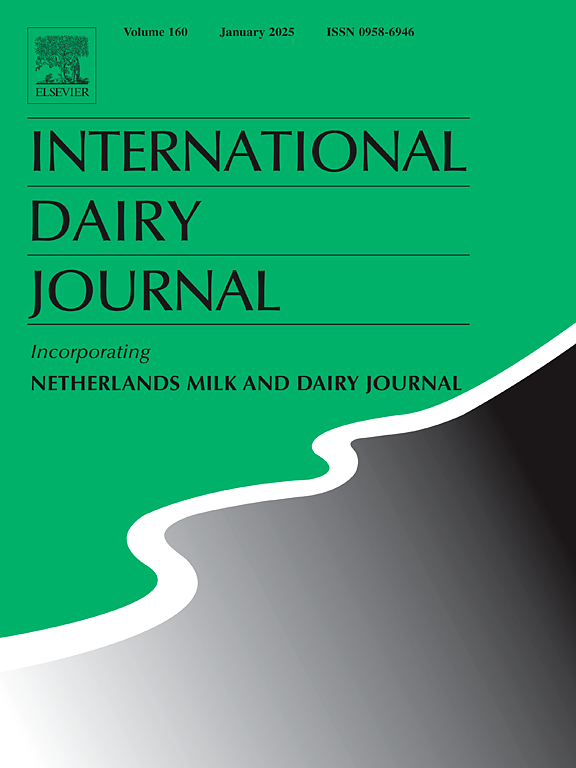模拟胃肠消化对红曲霉奶酪中蛋白质降解和生物活性肽的影响:肽组学和生物信息学研究
IF 3.4
3区 农林科学
Q2 FOOD SCIENCE & TECHNOLOGY
引用次数: 0
摘要
本研究研究了模拟胃肠消化对红曲霉奶酪最佳熟化期蛋白质降解和生物活性的影响。通过整合肽组学和生物信息学方法,我们全面分析了肽谱的变化,并确定了消化前后潜在的生物活性肽。在模拟胃肠道消化后,红曲霉奶酪中的大分子蛋白质进一步水解,产生低分子量肽和游离氨基酸。观察到肽谱的显著变化,伴随着显著的增加(P <;0.05)降低ace抑制活性、降糖活性和DPPH自由基清除能力。在不同消化阶段共鉴定出2631个乳蛋白衍生肽,包括69个推定的血管紧张素转换酶(ACE)抑制肽,32个抗氧化肽,21个二肽基肽酶- iv (DPP-IV)抑制肽和44个抗菌肽。值得注意的是,ACE抑制肽NLHLPLPLL、GPFPIIV和VENLHLPLPLL的峰强度最高,均超过109。分子对接分析表明,这些肽具有较低的结合自由能(- 5.84至- 6.76 kcal/mol),并与ACE活性口袋中的关键残基持续相互作用。分子动力学(MD)模拟验证了配合物的稳定性。这些发现为红曲霉奶酪的功能特性及其生物活性肽的生物利用度提供了重要的见解,为支持红曲霉奶酪未来的工业规模生产提供了理论基础和功能数据。本文章由计算机程序翻译,如有差异,请以英文原文为准。
Effects of simulated gastrointestinal digestion on protein degradation and bioactive peptides in Monascus cheese: a peptidomics and bioinformatics study
This study investigated the effects of simulated gastrointestinal digestion on protein degradation and bioactivity in Monascus cheese during its optimal ripening period. By integrating peptidomics and bioinformatics approaches, we comprehensively analyzed changes in peptide profiles and identified potential bioactive peptides before and after digestion. Following simulated gastrointestinal digestion, macromolecular proteins in Monascus cheese underwent further hydrolysis, yielding low-molecular-weight peptides and free amino acids. Significant alterations in peptide profiles were observed, accompanied by marked increases (P < 0.05) in ACE-inhibitory activity, hypoglycemic activity, and DPPH free radical scavenging capacity. A total of 2631 milk protein-derived peptides were identified across different digestion stages, including 69 putative angiotensin-converting enzyme (ACE) inhibitory peptides, 32 antioxidant peptides, 21 dipeptidyl peptidase-IV (DPP-IV) inhibitory peptides, and 44 antimicrobial peptides. Notably, the ACE inhibitory peptides NLHLPLPLL, GPFPIIV, and VENLHLPLPLL exhibited the highest peak intensities, all exceeding 109. Molecular docking analysis demonstrated that these peptides possessed low binding free energies (ranging from −5.84 to −6.76 kcal/mol) and consistently interacted with key residues in the ACE active pocket. Molecular dynamics (MD) simulation validated the stability of the complexes. These findings provide critical insights into the functional properties of Monascus cheese and the bioavailability of its bioactive peptides, offering both a theoretical foundation and functional data to support the future industrial-scale production of Monascus cheese.
求助全文
通过发布文献求助,成功后即可免费获取论文全文。
去求助
来源期刊

International Dairy Journal
工程技术-食品科技
CiteScore
6.50
自引率
9.70%
发文量
200
审稿时长
49 days
期刊介绍:
The International Dairy Journal publishes significant advancements in dairy science and technology in the form of research articles and critical reviews that are of relevance to the broader international dairy community. Within this scope, research on the science and technology of milk and dairy products and the nutritional and health aspects of dairy foods are included; the journal pays particular attention to applied research and its interface with the dairy industry.
The journal''s coverage includes the following, where directly applicable to dairy science and technology:
• Chemistry and physico-chemical properties of milk constituents
• Microbiology, food safety, enzymology, biotechnology
• Processing and engineering
• Emulsion science, food structure, and texture
• Raw material quality and effect on relevant products
• Flavour and off-flavour development
• Technological functionality and applications of dairy ingredients
• Sensory and consumer sciences
• Nutrition and substantiation of human health implications of milk components or dairy products
International Dairy Journal does not publish papers related to milk production, animal health and other aspects of on-farm milk production unless there is a clear relationship to dairy technology, human health or final product quality.
 求助内容:
求助内容: 应助结果提醒方式:
应助结果提醒方式:


